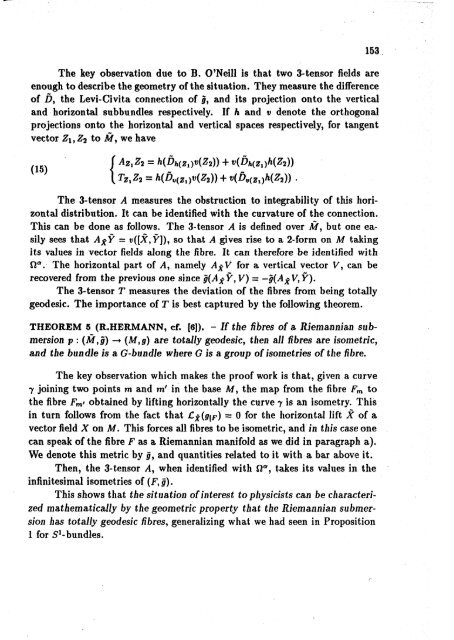Jean-Pierre Bourguignon A MATHEMATICIAN'S VISIT TO KALUZA ...
Jean-Pierre Bourguignon A MATHEMATICIAN'S VISIT TO KALUZA ...
Jean-Pierre Bourguignon A MATHEMATICIAN'S VISIT TO KALUZA ...
Create successful ePaper yourself
Turn your PDF publications into a flip-book with our unique Google optimized e-Paper software.
The key observation due to B. O'Neill is that two 3-tensor fields areenough to describe the geometry of the situation. They measure the difFerenceof D, the Levi-Civita connection of g, and its projection onto the verticaland horizontal subbundles respectively. If h and v denote the orthogonalprojections onto the horizontal and vertical spaces respectively, for tangentvector Z\,Z 2 to M, we have153(15) / A * lZ *= ^^1)^2)) + v &H*t) h ( z *)){T Zl Z 2 = h(D v(Zl) v(Z 2 )) + v(D v(Zl) h(Z 2 )) .The 3-tensor A measures the obstruction to integrability of this horizontaldistribution. It can be identified with the curvature of the connection.This can be done as follows. The 3-tensor A is defined over M, but one easilysees that A%Y = v([X,Y]), so that A gives rise to a 2-form on M takingits values in vector fields along the fibre. It can therefore be identified withQ°. The horizontal part of A, namely A%V for a vertical vector V, can berecovered from the previous one since g(A^Y,V) = -g(A^V f Y).The 3-tensor T measures the deviation of the fibres from being totallygeodesie. The importance of T is best captured by the following theorem.THEOREM 5 (R.HERMANN, cf. [6]). - If the fibres of a Riemannian submersionp : (M,g) —• (M,














